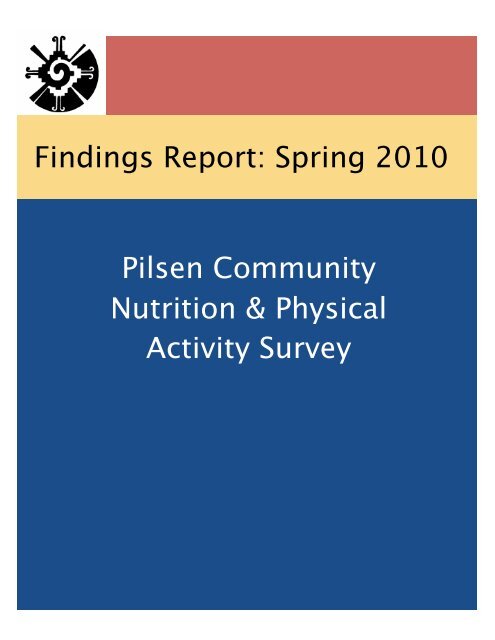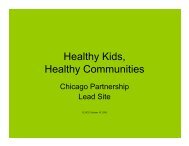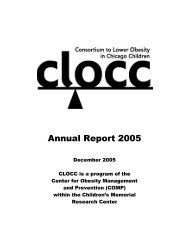Pilsen Community Nutrition and Physical Activity Survey
Pilsen Community Nutrition and Physical Activity Survey
Pilsen Community Nutrition and Physical Activity Survey
You also want an ePaper? Increase the reach of your titles
YUMPU automatically turns print PDFs into web optimized ePapers that Google loves.
Findings Report: Spring 2010<br />
<strong>Pilsen</strong> <strong>Community</strong><br />
<strong>Nutrition</strong> & <strong>Physical</strong><br />
<strong>Activity</strong> <strong>Survey</strong>
Introduction<br />
In the summer of 2009, El Valor <strong>and</strong> the Consortium to Lower Obesity in Chicago Children (CLOCC)<br />
conducted a survey of <strong>Pilsen</strong> residents. The purpose of the survey was to gather information<br />
about the current healthy lifestyle behaviors in children <strong>and</strong> caregivers. <strong>Survey</strong>ors asked<br />
neighborhood residents for information about weight status, physical activity habits, <strong>and</strong> nutrition<br />
<strong>and</strong> eating behaviors for themselves <strong>and</strong> a child in their care. The purpose of this study was (1) to<br />
find out how many children <strong>and</strong> child caregivers are overweight or obese, (2) to provide data to<br />
community organizations to use for program design or to apply for funding, <strong>and</strong> (3) to provide<br />
baseline information for future evaluation of community efforts towards child health.<br />
Key Findings<br />
Most adults (65%) in <strong>Pilsen</strong> are<br />
overweight or obese.<br />
Over half (54%) of children in <strong>Pilsen</strong><br />
are overweight or obese.<br />
Most adults (95.6%) think that<br />
obesity is a serious problem for<br />
adults <strong>and</strong> children in the community.<br />
Most adults (77%) do not believe<br />
that children in the neighborhood eat<br />
well.<br />
Less than half of caregivers report<br />
their child is eating the recommended<br />
5 or more servings of fruits <strong>and</strong><br />
vegetables daily.<br />
Most adults (74%) do not believe<br />
that children in the neighborhood get<br />
enough exercise.<br />
Most caregivers (90%) report their<br />
children meet the recommendation of<br />
1 hour or more of physical activity<br />
daily.<br />
50%<br />
40%<br />
30%<br />
20%<br />
10%<br />
0%<br />
Obesity Prevalence in <strong>Pilsen</strong><br />
April 28, 2010<br />
(n children=63, n adults=130)<br />
14%<br />
Children<br />
30%<br />
Overweight*<br />
Adults<br />
40%<br />
35%<br />
Obese**<br />
*Defined as BMI between 25 - 30 for adults <strong>and</strong> BMI<br />
in the 85th - 94.9th percentile for children.<br />
**Defined as BMI over 30 for adults <strong>and</strong> BMI in the<br />
95th percentile for children.<br />
3
Methods <strong>and</strong> Demographic Information<br />
Methods<br />
From the months of May – August, 2009, local resident surveyors approached adults at various<br />
locations around <strong>Pilsen</strong>. The adults were asked if they would like to participate in a survey about<br />
their health behaviors <strong>and</strong> those of a child in their care. Participants had to be the primary<br />
caregiver of a child between the ages of 2 <strong>and</strong> 18 years old <strong>and</strong> live within the area bordered by<br />
16th Street on the north, Cermak Road on the south, May Street on the east, <strong>and</strong> Western Avenue<br />
on the west. Participants completed the survey for themselves as well as the survey regarding<br />
their child’s behaviors. The adult portion of the survey consisted of 57 questions <strong>and</strong> the child<br />
portion consisted of 38 questions. Specific topics included demographics; weight status <strong>and</strong><br />
perceptions; nutrition – knowledge, attitudes <strong>and</strong> behaviors; physical activity – knowledge,<br />
attitudes <strong>and</strong> behaviors; stages of change; <strong>and</strong> healthy environment – perceived safety, grocery<br />
shopping, opportunities for physical activity, <strong>and</strong> child’s screen time. At the completion of the<br />
survey participants received a $15 Target gift card.<br />
Participant Demographics<br />
183 adults completed surveys for themselves <strong>and</strong> a child in their care. Because some children<br />
were outside the age range for this study, some surveys were excluded from the final results. The<br />
total of completed child surveys used was 167. Ninety-two percent of participants were female,<br />
while their children were more evenly split with 47% of children being female. Over half of the<br />
adult caregivers were the child’s mother (78%); other common relationships were father (8%),<br />
gr<strong>and</strong>parent (5%), aunt/uncle (4%), <strong>and</strong> sibling (4%). The adult participants’ ages ranged from<br />
18-65 with an average of 34 years. The children ranged in age from 2-18 with 40% between the<br />
ages of 2-5, 40% between the ages of 6-12, <strong>and</strong> 20% between the ages of 13-18 years.<br />
Household size ranged from 1-11 people, with about half of households having more than 4<br />
people. Half of participants have lived in <strong>Pilsen</strong> for more than 8 years.<br />
219<br />
Adults Screened<br />
19 Adults Ineligible:<br />
Missing/Incomplete screening form (3)<br />
Completed health survey in past month (8)<br />
Not the primary caregivers of a child 2-18 (3)<br />
Not > 18 years old (2)<br />
Refused participation (3)<br />
198<br />
Eligible <strong>and</strong> Consented<br />
183<br />
Completed Adult <strong>Survey</strong><br />
4<br />
16 Child <strong>Survey</strong>s Ineligible:<br />
Child was not between 2 - 18 years old<br />
167<br />
Completed Child <strong>Survey</strong>
Demographic Information<br />
Adult Demographics Percent or median/range N<br />
Race/Ethnicity<br />
Mexican<br />
Other Hispanic<br />
Black<br />
Other<br />
Missing<br />
82%<br />
13%<br />
3%<br />
2%<br />
.5%<br />
150<br />
22<br />
6<br />
4<br />
1<br />
Country of Birth<br />
U.S.<br />
Mexico<br />
Other<br />
25%<br />
71%<br />
3.8%<br />
46<br />
130<br />
7<br />
Years in the U.S. (if born outside<br />
U.S.)<br />
Median<br />
Range<br />
Primary Language*<br />
English<br />
Spanish<br />
English/Spanish<br />
Another Language<br />
No Response Given<br />
13<br />
1-45<br />
21%<br />
76%<br />
2%<br />
.6%<br />
.6%<br />
38<br />
137<br />
4<br />
1<br />
1<br />
<strong>Survey</strong> Language<br />
English<br />
Spanish<br />
28%<br />
72%<br />
51<br />
132<br />
Child Demographics Percent or median/range N<br />
Race/Ethnicity<br />
Mexican<br />
Mexican <strong>and</strong> Something Else**<br />
Other Hispanic<br />
Black<br />
Other<br />
Missing<br />
70%<br />
5%<br />
17%<br />
3%<br />
3%<br />
2%<br />
118<br />
8<br />
28<br />
5<br />
5<br />
3<br />
Country of Birth<br />
U.S.<br />
Mexico<br />
Puerto Rico<br />
91%<br />
7%<br />
1%<br />
149<br />
12<br />
2<br />
* Frequency missing 2. ** Mexican & Puerto Rican (1); Mexican & Other (4); Mexican & White (3).<br />
5
Weight Status <strong>and</strong> Perception - Children<br />
Children’s Weight Status (n=63)<br />
60%<br />
45%<br />
30%<br />
38%<br />
40%<br />
15%<br />
8%<br />
14%<br />
0%<br />
Underweight Normal Weight Overweight Obese<br />
Note: Many caregivers did not know their child’s height.<br />
Perception of Weight Status<br />
Caregiver Perception of Child’s Weight Status (n=165)<br />
80%<br />
60%<br />
64%<br />
40%<br />
20%<br />
10%<br />
26%<br />
0%<br />
Underweight/Slightly Underweight About the Right Weight Slightly Overweight/Overweight<br />
* 1.2% “Don’t Know”<br />
6
Weight Status <strong>and</strong> Perception - Adults<br />
75%<br />
Adult Weight Status (n=130)<br />
50%<br />
25%<br />
35%<br />
30%<br />
35%<br />
0%<br />
Under/Normal Overweight Obese<br />
Perception of Weight Status<br />
100%<br />
Caregiver Perception of Their Own Weight Status<br />
(n=130)<br />
75%<br />
50%<br />
25%<br />
8%<br />
21%<br />
30%<br />
42%<br />
0%<br />
Under Weight About the Right Weight Slightly Overweight Overweight<br />
7
Weight Status - Comparison With Other Locations<br />
Child Weight Status (2-18 years)<br />
Comparison with Sinai <strong>Survey</strong>, NYC <strong>and</strong><br />
National Data<br />
Prevalence of Obesity (Moderate,<br />
Severe, <strong>and</strong> Extreme) Among Adults<br />
(n=130)<br />
80%<br />
40%<br />
60%<br />
40%<br />
20%<br />
0%<br />
40% 34%<br />
24%<br />
16%<br />
14% 17% 19% 16%<br />
2009-<strong>Pilsen</strong>* Sinai-SL** NYC^ U.S.^^<br />
% Overweight % Obese<br />
* <strong>Pilsen</strong> & Little Village **2-12 years, South Lawndale<br />
^K-5 th grade ^^NHANES, 2003-2006<br />
30%<br />
20%<br />
10%<br />
0%<br />
9%<br />
5%<br />
22%<br />
<strong>Pilsen</strong>*<br />
4%<br />
8%<br />
15%<br />
Chicago**<br />
% Extreme (40+)<br />
% Severe (35-
Diet <strong>and</strong> <strong>Nutrition</strong> Findings - Children<br />
Food Choices<br />
Average # of<br />
servings<br />
Median # of servings<br />
Range of servings<br />
Fruits & Vegetables,<br />
not including juice<br />
Fruit, not including<br />
juice<br />
Vegetables, not<br />
including potatoes<br />
4.1 4 0-15<br />
1.7 2 0-6<br />
1 1 0-6<br />
Potatoes, not fried 0.3 0 0-6<br />
Potatoes, fried 0.4 0 0-6<br />
Fast Food 0.5 0 0-3<br />
High Sugar Foods<br />
(cookies, doughnuts,<br />
pastries, cakes, or<br />
popsicles)<br />
0.9 1 0-7<br />
How Often do You<br />
Give the Following<br />
Snacks to Your Child?<br />
% of caregivers<br />
who said often<br />
% of caregivers who<br />
said sometimes<br />
Combined % often/<br />
sometimes<br />
Fresh Fruit 72 24 96<br />
Fresh Vegetables 51 37 87<br />
Cheese 35 50 85<br />
Crackers 15 68 83<br />
Ice cream 24 57 81<br />
Cookies 19 52 71<br />
C<strong>and</strong>y 16 42 58<br />
Popcorn 6 46 52<br />
Canned Fruit 10 30 39<br />
Doughnut/Munchkins 8 27 35<br />
9
Diet <strong>and</strong> <strong>Nutrition</strong> Findings - Children<br />
Beverage Choices<br />
Mean Median Range<br />
Water 2.4 2 0-8<br />
Milk 2.1 2 0-8<br />
100% Fruit juice 1.3 1 0-12<br />
Soda 0.9 0 0-6<br />
Type of Milk Drank by Children (Note: 1% or skim is recommended)<br />
Type of milk Percent N<br />
Whole milk 23% 31<br />
2% milk 72% 97<br />
1% milk 1.5% 2<br />
Skim milk 2% 3<br />
Flavored milk 0.7% 1<br />
Don’t know 0.7% 1<br />
80%<br />
60%<br />
40%<br />
20%<br />
0%<br />
53%<br />
Soda <strong>and</strong> Sweetened Beverage Consumption Overall <strong>and</strong> by Age<br />
(Not Including 100% Fruit Juice)<br />
25%<br />
22%<br />
65%<br />
26%<br />
9%<br />
43%<br />
31%<br />
26%<br />
47%<br />
12%<br />
Total Sample 2-5 yrs 6-12 yrs 13-18 yrs<br />
0 servings 1 servings 2 or more servings<br />
p = .002<br />
41%<br />
10
Diet <strong>and</strong> <strong>Nutrition</strong> Findings - Fruit <strong>and</strong> Vegetable Intake<br />
Percent of Children Meeting the<br />
Recommendation to Eat 5 Servings of Fruits &<br />
Vegetables Each Day, by Age (n=167)<br />
100%<br />
75%<br />
Daily Servings of Fruits <strong>and</strong> Vegetables<br />
- Adults (n=183)<br />
71%<br />
75%<br />
50%<br />
50%<br />
25%<br />
39%<br />
38%<br />
30%<br />
25%<br />
16%<br />
13%<br />
0%<br />
2-5 years 6-12 years 13-18 years<br />
0%<br />
1%<br />
Diet <strong>and</strong> <strong>Nutrition</strong> Findings - Adults<br />
<strong>Nutrition</strong> Knowledge<br />
• Out of 11 nutrition knowledge questions, the average score was 79% correct with a median<br />
score of 82% correct <strong>and</strong> a range of 27% - 100% correct.<br />
• Most adults did not know the recommended number of servings of fruits <strong>and</strong> vegetables they<br />
should eat every day.<br />
• 29% answered correctly (5-10 servings).<br />
• The average of the responses was 3.7 servings, with a median of 3 <strong>and</strong> a range of 1-10.<br />
• Average nutrition scores increased with weight status (p=.049).<br />
• Underweight - average score = 8.4<br />
• Overweight - average score = 8.9<br />
• Obese - average score = 9.2<br />
• Adults born in the U.S. had a higher percentage of correct answers on average than those<br />
born outside the U.S.<br />
• Adults whose primary language was English had a higher percentage of correct answers on<br />
average than those whose primary language was Spanish.<br />
• The questions most often answered incorrectly were:<br />
• About how large is one serving of meat? (Correct Response: A deck of cards)<br />
• 42% answered incorrectly.<br />
• Most common incorrect response: “Both your h<strong>and</strong>s” - 19%.<br />
• Which has more fat: coleslaw or a green salad? (Correct Response: coleslaw)<br />
• 38% answered incorrectly.<br />
• Which has more fat: frozen yogurt or ice cream? (Correct Response: ice cream)<br />
• 25% answered incorrectly.<br />
How Often Do You Read the <strong>Nutrition</strong>-Related Information<br />
on Food Packages When Deciding What to Buy?*<br />
100%<br />
75%<br />
50%<br />
48%<br />
25%<br />
22%<br />
16%<br />
13%<br />
0%<br />
Always Sometimes Rarely Never<br />
12
Diet <strong>and</strong> <strong>Nutrition</strong> Findings - Adults<br />
Servings of Different Food Items Per Day<br />
Mean Median Range<br />
Fruits & Vegetables 8.4 7 0-29<br />
Fruit, not including<br />
juice<br />
2.2 2 0-7<br />
100% Fruit juice 1.7 1 0-7<br />
Vegetables, not<br />
including potatoes<br />
1.8 2 0-7<br />
Green Salad 1.7 1 0-7<br />
Potatoes, not fried 1.1 1 0-6<br />
Potatoes, fried 1.1 1 0-6<br />
Average Intake of Different Food Items Per Week<br />
5+ days/week 1-4 days/week
Diet <strong>and</strong> <strong>Nutrition</strong> Findings - Adults<br />
Importance of Diet <strong>and</strong> <strong>Nutrition</strong><br />
How Important Is: % Very important % Somewhat<br />
important<br />
Combined % very or<br />
somewhat important<br />
Maintaining a healthy diet? 87 11 98<br />
Choosing a diet with plenty<br />
of fruits & veggies?<br />
81 14 95<br />
Choosing a diet low in fat? 78 17 95<br />
Eating a variety of foods? 73 20 93<br />
Diet <strong>and</strong> nutrition to you<br />
personally?<br />
Eating at least 2 servings of<br />
dairy products/day?<br />
Choosing a diet with plenty<br />
of breads, cereals, rice, <strong>and</strong><br />
pasta?<br />
69 22 92<br />
62 28 90<br />
28 31 59<br />
Perceptions About Diet <strong>and</strong> Barriers to Healthy Eating<br />
% Strongly<br />
agree<br />
% Agree Combined % strongly<br />
agree/agree<br />
I eat more on weekends 16 42 58<br />
Some people are meant to be overweight 4 30 34<br />
I eat more when I’m alone than when I eat<br />
around others<br />
14 24 37<br />
If I’m craving food, my body must need it 6 32 39<br />
With my schedule, it’s impossible to eat right 15 43 57<br />
There’s too much stress in my life for me to<br />
effectively manage my weight<br />
When I’ve done something good, I reward<br />
myself with food<br />
21 36 57<br />
4 28 31<br />
14
Diet <strong>and</strong> <strong>Nutrition</strong> Findings - Other Factors<br />
Store Options <strong>and</strong> Food Availability<br />
Most frequently used grocery stores<br />
Aldi – 55.7%<br />
Cermak Produce – 54.1%<br />
El Guero - 42.1%<br />
Casa del Pueblo - 37.2%<br />
Pete’s Market - 33.9%<br />
Jewel/Osco - 17.5%<br />
Level of Satisfaction with the Selection of<br />
Food Items at the Store Where Adults<br />
Usually Shop for Food:<br />
60%<br />
40%<br />
20%<br />
0%<br />
60%<br />
Very Satisfied<br />
Not Too Satisfied<br />
32%<br />
4%<br />
2%<br />
Level of Satisfaction<br />
Somewhat Satisfied<br />
Not At All Satisfied<br />
In an Average Week, on How Many<br />
Evenings Does Your Family Eat Dinner at<br />
Home Together?<br />
(n=165)<br />
Mean Median p-value<br />
Overall 5.2 7 n/a<br />
Country<br />
of origin<br />
U.S.<br />
Not U.S.<br />
Primary<br />
language<br />
English<br />
Spanish<br />
4.5<br />
6.2<br />
4.3<br />
6.1<br />
5<br />
7<br />
5<br />
7<br />
t-test:<br />
p=.06<br />
Wilcoxon:<br />
p=.022<br />
t-test:<br />
p=.043<br />
Wilcoxon:<br />
p=.013<br />
Factors Influencing Decisions when Eating or Purchasing Food<br />
Convenience<br />
19%<br />
70%<br />
Knowing how to prepare food<br />
9%<br />
86%<br />
Selection<br />
Price<br />
18%<br />
17%<br />
76%<br />
80%<br />
Meets my tastes/preferences<br />
Meets my family’s tastes/preferences<br />
27%<br />
26%<br />
70%<br />
70%<br />
Quality<br />
7%<br />
92%<br />
0% 20% 40% 60% 80% 100%<br />
Very Important<br />
Somewhat Important<br />
15
<strong>Physical</strong> <strong>Activity</strong> Findings - Children<br />
Active Play Per Day<br />
90% of children participate in active play for more than 1 hour/day.<br />
50% of children participate in active play for more than 2 hours/day.<br />
Screen Time Per Day<br />
% 2 hrs or less per<br />
day<br />
Mean<br />
(minutes)<br />
Median<br />
(minutes)<br />
Range<br />
(minutes)<br />
TV Time 49% 165 150 0-720<br />
Video Games/ Computer 86% 70 60 0-600<br />
Total Screen Time 30% 228 180 15-840<br />
Child Screen Time by<br />
Age of Caregiver<br />
<strong>Physical</strong> <strong>Activity</strong> Findings - Adults<br />
<strong>Physical</strong> <strong>Activity</strong> Knowledge<br />
How much moderate physical activity does an average adult need per day to maintain good health?<br />
69% of respondents answered correctly: 30-60 minutes.<br />
Most frequent incorrect answers: 120 minutes (14%) <strong>and</strong> 20 minutes (12%).<br />
Statement<br />
Correct answer<br />
Percent of adults who<br />
responded correctly<br />
Regular physical activity can<br />
improve your health<br />
TRUE 97%<br />
<strong>Physical</strong> activity is as<br />
important as diet in helping<br />
someone lose weight<br />
TRUE 92%<br />
You have to train like a<br />
marathon runner to become<br />
more physically fit<br />
FALSE 87%<br />
It takes a lot of money or<br />
expensive equipment to<br />
become fit<br />
FALSE 86%<br />
People who need to lose<br />
weight are the only ones who<br />
benefit from physical activity<br />
FALSE 78%<br />
Simply walking is strenuous<br />
enough to help maintain<br />
good health<br />
TRUE 71%<br />
Most people get enough<br />
physical activity from their<br />
daily routine<br />
FALSE 50%<br />
17
<strong>Physical</strong> <strong>Activity</strong> Findings - Adults<br />
Barriers to <strong>Physical</strong> <strong>Activity</strong><br />
% Strongly agree % Agree<br />
Combined % agree/<br />
strongly agree<br />
I’ve been thinking about being<br />
more physically active, but I<br />
just can’t seem to get started<br />
9 51 60<br />
I am just too tired after work<br />
to engage in physical activity<br />
10 37 47<br />
My usual social activities with<br />
family or friends don’t include<br />
physical activity<br />
7 34 41<br />
My free time during the day is<br />
too short to include physical<br />
activity<br />
8 30 38<br />
I don’t have access to jogging<br />
trails, swimming pools, bike<br />
paths, etc.<br />
7 21 28<br />
<strong>Physical</strong> activity takes too<br />
much time away from other<br />
commitments – work, family,<br />
etc.<br />
4 24 28<br />
I’m embarrassed about how I<br />
will look when I engage in<br />
physical activity with others<br />
3 17 20<br />
I don’t have enough money to<br />
be physically active<br />
2 18 20<br />
I don’t like being physically<br />
active<br />
3 15 19<br />
18
<strong>Physical</strong> <strong>Activity</strong> Findings - Adults<br />
Screen Time<br />
Half of adults spend more than 2 hours watching TV each day.<br />
Half of adults spend more than 1 hour using a computer each day.<br />
Obese adults spend more time watching TV each day than under/normal weight adults <strong>and</strong><br />
overweight adults (p-ANOVA = .0093, p-Krusakal-Wallis = .02):<br />
3.1 hours on average per day for obese adults (median 3).<br />
2.1 hours on average per day for under/normal weight <strong>and</strong> overweight adults (median 2).<br />
<strong>Physical</strong> <strong>Activity</strong> Behavior<br />
53% meet the CDC’s recommendation of 20<br />
minutes of vigorous or 30 minutes of moderate<br />
physical activity 5 or more days per week.<br />
<br />
Most common activities:<br />
69% - Walking<br />
18% - Dancing/Aerobics<br />
16% - Jogging/Running<br />
9% - Bicycling<br />
9% - Swimming<br />
9% - Other<br />
<strong>Community</strong> Conditions<br />
95% of adults say there is a “park, playground, or<br />
open space” within walking distance of their<br />
home.<br />
73% of adults agree the park/playground walking<br />
distance from their house is safe during the day.<br />
67% of adults indicate they would walk more<br />
often if they felt safer in their neighborhood.<br />
55% of adults feel comfortable having their child<br />
play outside in the community.<br />
On How Many of the Past 7 Days<br />
Did You do Any Kind of <strong>Physical</strong><br />
<strong>Activity</strong> in a Place Such as a “Y,”<br />
Gym, Etc.?<br />
8%<br />
7%<br />
5% 1%<br />
79%<br />
0 Days 1-2 Days<br />
3-4 Days 5-7 Days<br />
Don’t Know<br />
Average Hours Spent <strong>Physical</strong>ly Active Per Day<br />
4<br />
3.4<br />
3<br />
1<br />
1.0<br />
0.8<br />
0.7<br />
0<br />
<strong>Physical</strong> Labor (Home/Work) Walk/Bike for Transportation Walk/Bike for Health Walk/Bike for Leisure<br />
19
Eating Right <strong>and</strong> Being Healthy are as Easy as:<br />
5 Servings of fruits <strong>and</strong> vegetables a day<br />
4 Servings of water a day<br />
3 Servings of low fat dairy a day<br />
2 Hours or less of screen time a day<br />
1 Hour or more of physical activity a day<br />
Support was Provided by:<br />
The Chicago <strong>Community</strong><br />
Trust<br />
Kraft Foods<br />
Michael Reese Health<br />
Trust<br />
The Otho S. A. Sprague<br />
Memorial Institute<br />
Contact Information<br />
For more information about programs <strong>and</strong> resources to<br />
address healthy living in <strong>Pilsen</strong>, please contact:<br />
Araceli Garza<br />
araceli.garza@elvalor.net<br />
For more information about the survey or survey results,<br />
please contact:<br />
Lara Jaskiewicz, MPH, MBA<br />
CLOCC<br />
312-573-7759<br />
ljaskiew@childrensmemorial.org<br />
Sarah Welch, MPH<br />
CLOCC<br />
312-573-7767<br />
swelch@childrensmemorial.org<br />
To download a copy of this report, please visit:<br />
www.clocc.net<br />
20





